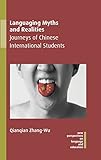Languaging Myths and Realities : Journeys of Chinese International Students / Qianqian Zhang-Wu.
Material type: TextSeries: New Perspectives on Language and Education ; 95Publisher: Bristol ; Blue Ridge Summit : Multilingual Matters, [2021]Copyright date: ©2022Description: 1 online resource (288 p.)Content type:
TextSeries: New Perspectives on Language and Education ; 95Publisher: Bristol ; Blue Ridge Summit : Multilingual Matters, [2021]Copyright date: ©2022Description: 1 online resource (288 p.)Content type: - 9781788926898
- 9781788926904
- Chinese students -- United States
- Chinese students -- United States
- Chinese -- United States -- Communication
- College freshmen -- Services for -- United States
- College freshmen -- Services for -- United States
- English language -- Study and teaching (Higher) -- Chinese speakers
- Foreign study -- Social aspects -- United States
- Intercultural communication
- Students, Foreign -- United States
- Bilingualism & multilingualism
- Higher & further education, tertiary education
- Migration, immigration & emigration
- LANGUAGE ARTS & DISCIPLINES / Linguistics / General
- 428.00711 23/eng/20230216
- LB2376.5.C6 Z47 2022
- online - DeGruyter
| Item type | Current library | Call number | URL | Status | Notes | Barcode | |
|---|---|---|---|---|---|---|---|
 eBook
eBook
|
Biblioteca "Angelicum" Pont. Univ. S.Tommaso d'Aquino Nuvola online | online - DeGruyter (Browse shelf(Opens below)) | Online access | Not for loan (Accesso limitato) | Accesso per gli utenti autorizzati / Access for authorized users | (dgr)9781788926904 |
Browsing Biblioteca "Angelicum" Pont. Univ. S.Tommaso d'Aquino shelves, Shelving location: Nuvola online Close shelf browser (Hides shelf browser)
Frontmatter -- Contents -- Acknowledgements -- Preface -- Part 1 -- 1 Who, Why and What about Chinese International Students -- 2 Languaging across Borders: Linguistic Demands, Challenges and an Integrated Framework -- 3 A Four-Month In-Depth Investigation: An Overview of Study Design -- Part 2 -- 4 Chinese International Students are Not Chinese International Students -- 5 First Semester Languaging Journeys of Three Regular High Students -- 6 First-Semester Languaging Journeys of Two American High Students -- 7 Revisiting Within-Group Variabilities among Chinese International Students -- Part 3 -- 8 An Overview of Myths and Realities -- 9 Myth 1: TOEFL Results Accurately Predict International Students’ Ability to Function Linguistically on College Entry -- 10 Myth 2: An English-Only Policy is Necessary in College Classrooms to Help International Students Improve Their Linguistic Functioning in English -- 11 Myth 3: First Year Writing Guarantees International Students’ Successful Writing Performances in Content-Area Courses -- 12 Myth 4: English is Responsible for All the Challenges Facing Chinese International Students -- 13 Myth 5: Chinese International Students are Well Supported in American Higher Education Linguistically and Academically -- 14 Revisiting Myths and Realities -- Appendix A -- Appendix B -- References -- Index
restricted access online access with authorization star
http://purl.org/coar/access_right/c_16ec
Drawing on a digital ethnography of Chinese international students’ first semester languaging practices, this book examines how they use their multilingual and multi-modal communicative repertories to facilitate languaging across contexts, in order to suggest how universities might better serve the needs of international students.
Mode of access: Internet via World Wide Web.
In English.
Description based on online resource; title from PDF title page (publisher's Web site, viewed 25. Jun 2024)









